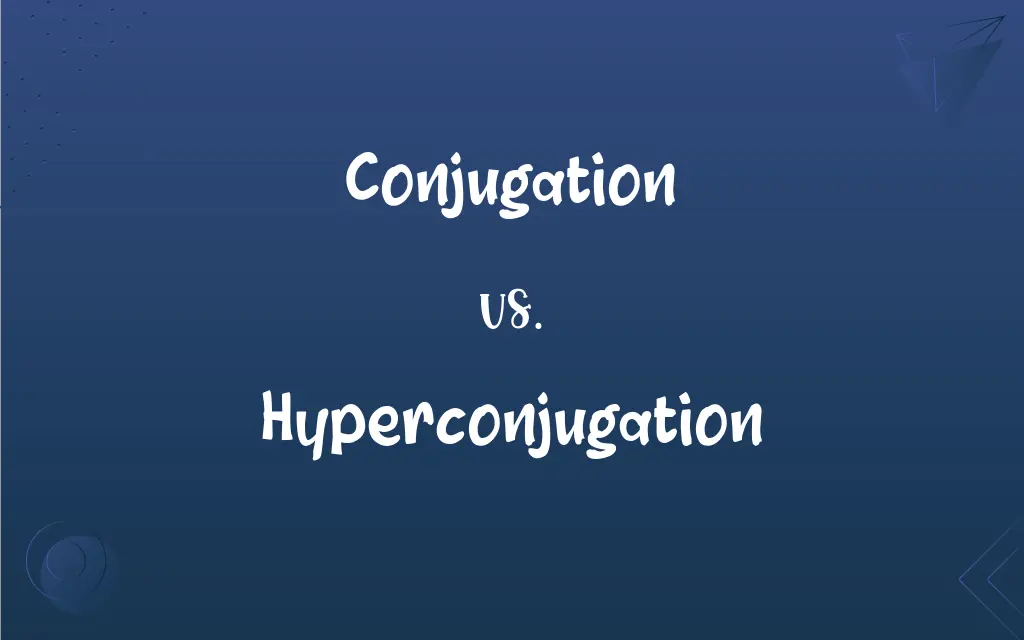Conjugation vs. Hyperconjugation: What's the Difference?
Edited by Janet White || By Harlon Moss || Updated on October 18, 2023
Conjugation involves the delocalization of π electrons across alternating single and double bonds, while hyperconjugation involves the delocalization of σ electrons from C-H bonds adjacent to a π system.

Key Differences
Conjugation is a phenomenon observed in organic compounds where π electrons get delocalized over alternating single and double bonds. On the other hand, hyperconjugation involves the interaction between σ electrons of a C-H bond and an adjacent empty or partially filled π orbital or p orbital.
Conjugation typically stabilizes a molecule due to the delocalization of electrons, reducing electron repulsion. Hyperconjugation, while also a stabilizing effect, works through the spreading of electron density from the σ bond to an adjacent unsaturated system.
A common example of conjugation can be found in compounds like butadiene, where electrons move across the alternating single and double bonds. In contrast, hyperconjugation can be witnessed in carbocations, where the adjacent C-H bonds provide stabilization.
The requirement for conjugation is a continuous system of p orbitals, which may involve alternating single and double bonds, or even lone pairs or radicals. Hyperconjugation, however, requires only an adjacent σ bond and a suitable empty or partially filled p or π orbital.
While both conjugation and hyperconjugation are delocalization effects and contribute to the stabilization of molecules, they differ in the source of electrons - π electrons in conjugation and σ electrons in hyperconjugation.
ADVERTISEMENT
Comparison Chart
Type of electrons involved
π electrons
σ electrons from C-H bonds
Requirements
Alternating single and double bonds, p orbitals
Adjacent σ bond and an empty or partially filled orbital
Stabilizing effect
Reduces electron repulsion due to delocalization
Spreads electron density to unsaturated system
Example compounds
Butadiene, benzene
Tertiary carbocations
Type of delocalization
Across p orbitals
Between σ bond and adjacent π or p orbital
ADVERTISEMENT
Conjugation and Hyperconjugation Definitions
Conjugation
Presence of alternating single and double bonds.
The molecule has conjugation, giving it a planar structure.
Hyperconjugation
Involvement of C-H bonds in electron delocalization.
Hyperconjugation explains the unexpected stability of the compound.
Conjugation
Delocalization of π electrons across alternating bonds.
Benzene exhibits conjugation due to its cyclic structure.
Hyperconjugation
Interaction between a σ bond and an adjacent empty p or π orbital.
The alkyl group exerts a hyperconjugation effect on the carbocation.
Conjugation
A phenomenon leading to resonance structures.
Due to conjugation, several resonance forms of the compound are possible.
Hyperconjugation
Delocalization of σ electrons to adjacent unsaturated systems.
Hyperconjugation stabilizes the positive charge in carbocations.
Conjugation
Stabilization through continuous overlapping p orbitals.
The extended conjugation in the dye makes it highly colored.
Hyperconjugation
A type of no-bond resonance.
The molecule's stability can be attributed to hyperconjugation.
Conjugation
Electron cloud spread over several adjacent atoms.
Conjugation enhances the molecule's stability and lowers its reactivity.
Hyperconjugation
σ bond electrons providing stabilization to adjacent unsaturated centers.
In tertiary carbocations, hyperconjugation from multiple C-H bonds occurs.
Conjugation
The act of conjugating.
Hyperconjugation
(organic chemistry) A weak form of conjugation in which single bonds interact with a conjugated system
Conjugation
The state of being conjugated.
FAQs
How does hyperconjugation differ from conjugation?
Hyperconjugation involves delocalization of σ electrons from C-H bonds adjacent to a π system.
What's the significance of hyperconjugation in carbocations?
Hyperconjugation stabilizes carbocations by spreading electron density from adjacent C-H bonds.
Is conjugation only seen in cyclic compounds?
No, conjugation can occur in both cyclic and acyclic compounds with alternating single and double bonds.
What does conjugation involve in chemistry?
Conjugation involves the delocalization of π electrons across alternating single and double bonds.
Does conjugation affect a compound's color?
Yes, extended conjugation can lead to visible colors in organic compounds.
Can hyperconjugation affect alkene stability?
Yes, hyperconjugation can contribute to the stability of certain alkenes.
Why is hyperconjugation called "no-bond resonance"?
Because it involves electron delocalization without the typical bond-breaking seen in resonance.
Can hyperconjugation explain the order of carbocation stability?
Yes, greater hyperconjugation often leads to increased carbocation stability.
Is benzene an example of conjugation?
Yes, benzene is a classic example due to its continuous π system.
Is hyperconjugation a stronger or weaker effect than conjugation?
Conjugation is generally considered a stronger effect than hyperconjugation.
How does conjugation affect UV-visible absorption?
Extended conjugation can shift UV-visible absorption to longer wavelengths.
Can molecules have both conjugation and hyperconjugation?
Yes, certain molecules can exhibit both effects, depending on their structure.
How does conjugation affect molecular planarity?
Conjugation often favors planarity as it allows better overlap of p orbitals.
Can lone pairs participate in conjugation?
Yes, lone pairs on atoms with p orbitals can participate in conjugation.
How do molecules attain stability through conjugation?
Conjugation reduces electron repulsion by allowing delocalization of π electrons.
What types of orbitals are involved in hyperconjugation?
Hyperconjugation involves σ bonds and adjacent empty or partially filled p or π orbitals.
Is conjugation always beneficial for a molecule's stability?
Generally, yes. Conjugation typically increases molecular stability.
In which functional groups is hyperconjugation observed?
Hyperconjugation is commonly observed in carbocations, alkenes, and radicals.
Do all compounds with double bonds show conjugation?
No, only compounds with alternating single and double bonds show conjugation.
Is hyperconjugation a type of resonance?
Hyperconjugation is often referred to as "no-bond resonance."
About Author
Written by
Harlon MossHarlon is a seasoned quality moderator and accomplished content writer for Difference Wiki. An alumnus of the prestigious University of California, he earned his degree in Computer Science. Leveraging his academic background, Harlon brings a meticulous and informed perspective to his work, ensuring content accuracy and excellence.
Edited by
Janet WhiteJanet White has been an esteemed writer and blogger for Difference Wiki. Holding a Master's degree in Science and Medical Journalism from the prestigious Boston University, she has consistently demonstrated her expertise and passion for her field. When she's not immersed in her work, Janet relishes her time exercising, delving into a good book, and cherishing moments with friends and family.































































